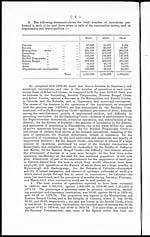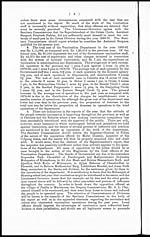Medicine - Vaccination > 1874-1889 - Report on vaccination in the Province of Bengal > Report on vaccination in the Province of Bengal for 1880-81
(509) Page 3
Download files
Individual page:
Thumbnail gallery: Grid view | List view

( 3 )
altogether worthless. In the Ranchi Circle, the success in secondary operations
is actually shown as greater than in primary operations, and in the Sonthal
Pergunnahs, the proportion of successful secondary operations to the total
number of such operations is entered at 94.62 per cent. With such figures as
these before him, it is difficult for the Lieutenant-Governor to place much
reliance on the returns furnished by the same operators of their success in pri-
mary vaccination. All that can be said of those returns is that they are not
inherently improbable, and do not bear on their face the evidence of their own
untrustworthiness. The figures for Calcutta and the Suburbs can probably be
depended upon, and these show respectively 8.06 and 17.85 as the percentage
of successful operations in secondary vaccinations.
5. The average number of operations performed by each vaccinator
during 1880-81, was 1,256 against 1,443 in 1879-80, and 1,191 in 1878-79.
Increased work was performed by each operator in the Sonthal Pergunnahs,
Orissa, and Behar Circles, but in all the other circles there was a decrease.
The average number of operations performed by each vaccinator was highest
in the Darjeeling and Eastern Bengal Circles where it was 1,870 and 1,721
respectively, and lowest in Calcutta where it was only 434. In the Suburbs
the average number of operations per vaccinator was 1,207.
6. The sex of 1,394,080 of the persons vaccinated was registered. Of
these 730,685 were males, and 663,395 females, giving a percentage of 52.41
males to 47.59 females Of the total number (1,360,038) of successful primary
operations, only 166,853 were performed on children under one year of age,
824,358 on children between one year and six years old, and 368,827 on
children above six years of age and adults. The circles in which the
number of children vaccinated bore the highest proportion to the total number
of vaccinations were Calcutta, the Suburbs, and Ranchi, where 43.84, 24.20, and
27.39 per cent. respectively of those operated on were below one year of age.
The high percentage in Calcutta is especially noteworthy, as the operations
were conducted during part of the year under a new system introduced in
accordance with the provisions of the Bengal Vaccination Act, V (B.C.) of 1880.
It appears, however, from the table given in paragraph 21 of the report that
even in the tracts in which the best protection is afforded to infants only a
small proportion of the children born are vaccinated in the first year after their
birth. Taking the birth-rate at so low an estimate as 30 per thousand of the
population, the number of infants under one year of age vaccinated in the
year was only 13.94 per cent. of the number born in the areas under opera-
tion. In the Ranchi Circle where the percentage was highest it was 37.4, in
the Suburbs of Calcutta it was 26.78, in the Darjeeling Circle 18.63, and
in Calcutta 17.32. In Orissa where vaccination has been much neglected
the. percentage was only 3.42.
7. The total number of villages visited by officers of the Vaccination
Department during the year was 21,628, while the number of cases
inspected was 918,049 out of 1,326,628 cases within the area of inspection.
Of vaccinations performed by the paid staff, 56.79 per cent. were inspected, the
percentage being highest in the Sonthal Pergunnahs where it was 80.28, and
lowest in Eastern Bengal where it was only 44.61. Except in the Metropolitan
Circles, where the proportion of inspections to the total number of vaccinations
was 123.27 per cent., the duty of inspection was very insufficiently performed
in the circles in which the system of licensed vaccination was in force. In the
Sonthal Pergunnahs only 47.82 per cent. of the operations of licensed vaccina-
tors were inspected, in the Ranchi Circle only 46.20, in the Darjeeling Circle
only 33.24, and in Eastern Bengal only 18.99 per cent. The Deputy Superin-
tendent of the latter circle appears to have altogether neglected the duties of
his office; but it is unnecessary for the Lieutenant-Governor to say here anything
more upon the subject, as a special report is to be submitted by the Superintend-
ent to the Sanitary Commissioner. The punishment of degradation to a lower
grade inflicted on the head vaccinator in the Eastern Bengal Circle, who
submitted false returns and fictitious statements of inspections and concealed
extortion on the part of one of his subordinates, appears to the Lieutenant-
Governor to be wholly inadequate. If the offences charged were all clearly
proved, the man should be dismissed. The vaccinator against whom a charge
of extortion is reported to have been established should also be discharged,
Set display mode to: Large image | Zoom image | Transcription
Images and transcriptions on this page, including medium image downloads, may be used under the Creative Commons Attribution 4.0 International Licence unless otherwise stated. ![]()
| India Papers > Medicine - Vaccination > Report on vaccination in the Province of Bengal > Report on vaccination in the Province of Bengal for 1880-81 > (509) Page 3 |
|---|
| Permanent URL | https://digital.nls.uk/91537707 |
|---|
| Additional NLS resources: | |
|---|---|




